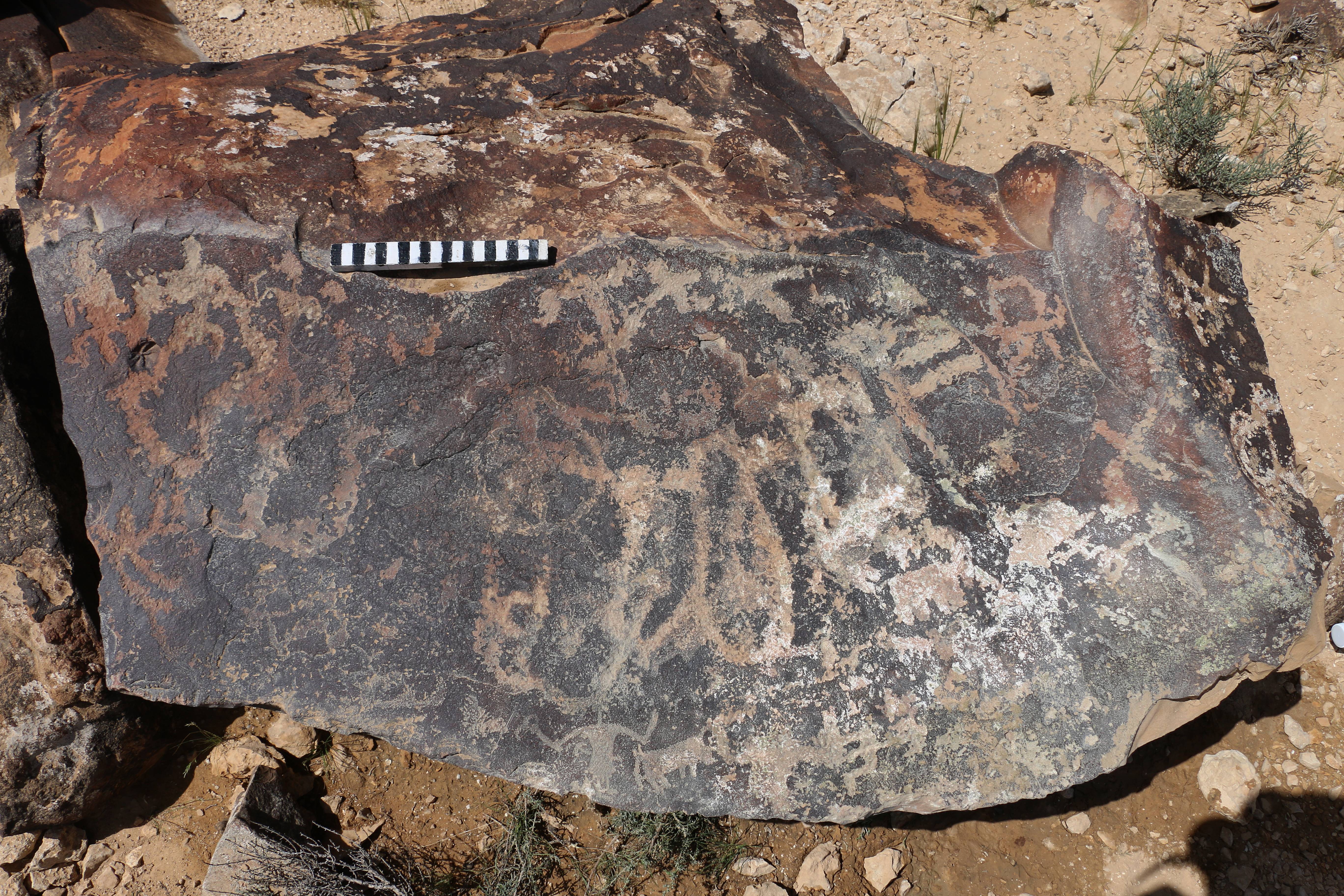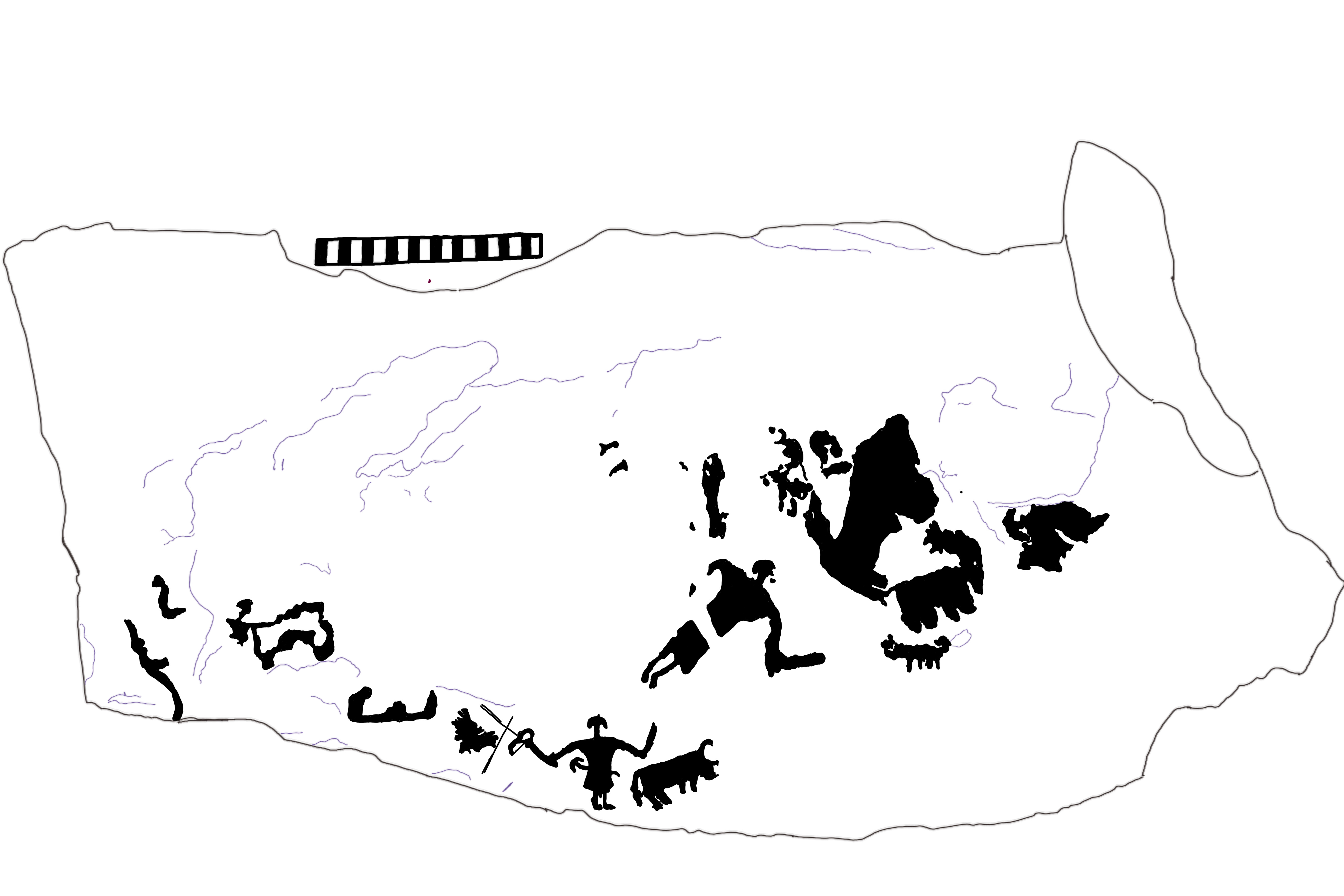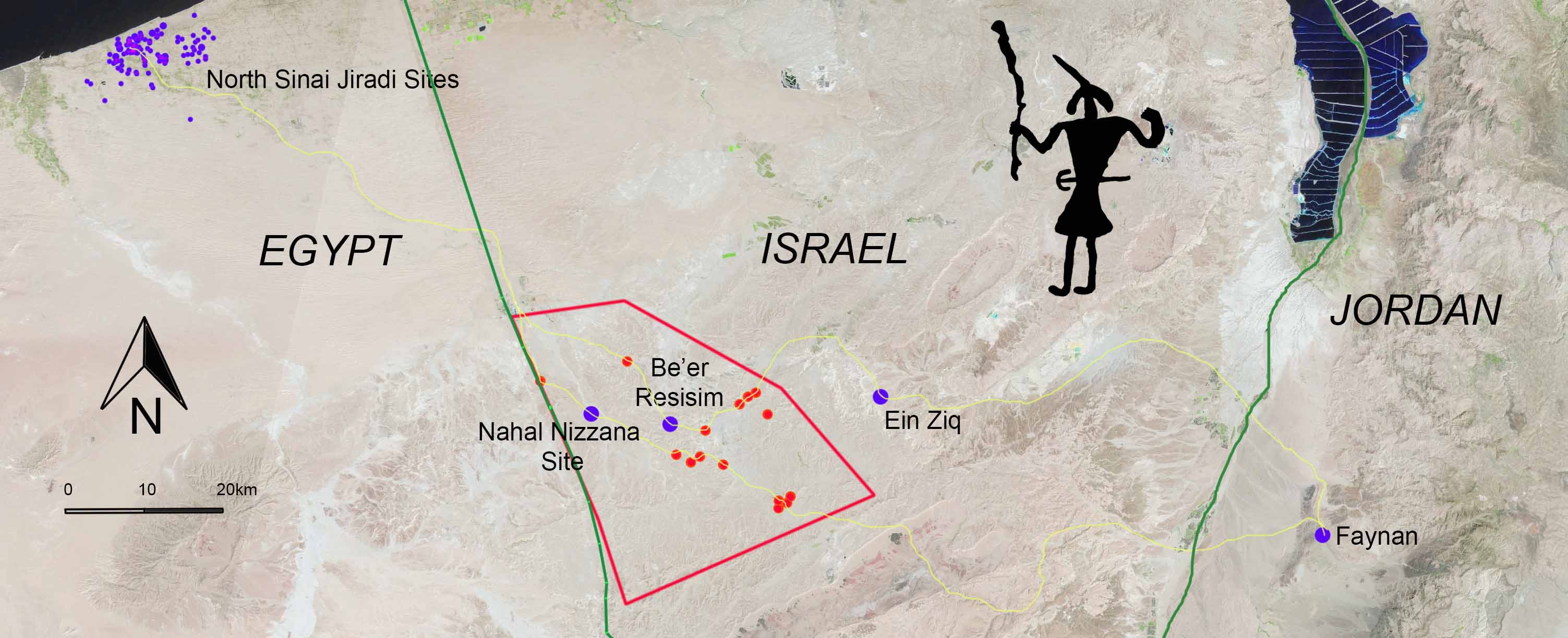By Lior Schwimer and Yuval Yekutieli
The Negev is renowned for its countless examples of rock art, which date from remote proto-history until the modern period. Many of these are difficult to date, but new research suggests that a special class dates to the still enigmatic mid-third millennium BCE. Do they indicate something unexpected about that society?
Over the last five years an extensive documentation project has been conducted in the western Negev Highlands by Lior Schwimer on behalf of the Israel Nature and Parks Authority. The survey's goal is to document and analyze the thousands of petroglyphs scattered in the area. This brief report presents the discovery of a unique type of petroglyphs proposed to be associated with the Intermediate Bronze Age (2500-2000 BCE) and a unique socio-economic system that operated in the region of the Negev, Sinai, and Southern Jordan.
The Western Negev Highlands and Its Rock Art
The Western Negev Highlands includes the basins of Naḥal Zin and Naḥal Nizzana, Ramat Matred, and the Nafḥa and Ḥamran ridge in the center of that plateau. The survey area is comprised of limestone hills; one of its characteristic features is concentrations of rocks with a dark crust or patina, comprised of micro-organisms, clay minerals, and oxides and hydroxides of iron and/or manganese. These rocks appear as layers, outcrops, or separate boulders, and may occur in riverbeds, mountaintops or on the slopes.
A special characteristic of these dark rocks is that when their patina is scratched, the light color of the stone is revealed. Ancient inhabitants of the region were familiar with this and by pecking, incising or carving, removed the patina to create various designs. The etched scenes are clearly visible due to the contrast between the dark patina and the light-colored stone.
Petroglyphs in the Negev were carved over an immensely long period of time, and in many cases individual rock panels were repeatedly incised at different times. But since new patina is continually formed on the rock face, older engravings gradually turn dark until they eventually regain the original color of the patina that covers the entire surface. In cases of multiple engravings on the same rock surface, the different hues of the etched scenes and their overlap may make it possible to discern the order in which the scenes were engraved. In addition, specific images may give clues to absolute dating. For example, since the camel was domesticated in the Negev during the beginning of the first millennium BCE, a carving depicting men riding camels can only be from that date onwards.
The Crescent Headed Figures
During the survey thousands of engraved images, abstract symbols as well as inscriptions, were found. Within this massive corpus, however, we have noticed certain designs that have been rarely described before. Furthermore, certain unique designs cluster consistently, systematically appearing in close association with each other. The most significant is what we label 'crescent headed figures', which come with a customary set of associated emblems and accompanying animals.
The basic shapes of the ‘crescent headed figures’ are finely pecked human figures with an hour glass shaped body, crescent shaped head-cover, and a decoration at its tip. Daggers with crescent pommel handles are secured to their waists, and at times they seem to have additional garments. Moreover, these figures are consistently accompanied by engravings of lions, bulls, or both. This is remarkable, especially since these animals are rarely depicted in other Negev petroglyphs.
Two such compositions provide excellent examples for this artistic composition: the Har Nafḥa panel, and the Ramat Matred panel. The Har Nafḥa panel is comprised of six superimposed layers of engravings of different ages. The lowermost, oldest layer includes seventeen crescent headed human figures, a lion, canines, and ibexes. Two of the human figures are kneeling, while three seem to be holding a lightning-shaped natural fissure of the rock. Some of the figures hold small recurved bows and some grasp torch-like objects.
The Ramat Matred panel consists of four different layers of engravings. The lowermost, oldest layer presents two crescent headed figures. The figure at the bottom of the panel fires an arrow with a small recurved bow while standing next to a bull. A second figure, in the middle of the scene, is depicted next to a lion. This figure is engraved horizontally, a posture that might suggest death.
How can we date these scenes? For one thing, the crescent headed figures almost always appear in the lowermost (oldest) layers of multi-period panels, thus they originate in a very early phase within the rock art history of the Negev. Supporting the hypothesis of their extreme age is the fact that their hue is always very close to the original dark patina of the rock.
Another indication for the age of crescent headed figures is the fact that they never appear in combination with camels and horses. Since the latter were domesticated and introduced into the Negev in roughly the first millennium BCE (a period where they are frequently depicted in local rock art), the crescent headed figures’ scenes should be older.
One clue for the absolute dating of these compositions might be the uniquely shaped daggers the crescent headed figures carry. Daggers with similar crescent shaped handles have been recovered from burials in Mesopotamia, the southern Levant, the Nile Delta and Sudan, and range in date from 2400 to 1900 BCE. In addition, similar daggers are depicted on tombstones from south Arabia, where there are petroglyphs similar to the crescent headed figures of the Negev Highlands. The South Arabian figures are commonly dated to the Bronze Age (which covers the time from the 4th to the 2nd millennia BCE).
The Crescent Headed Figures in Social and Historical Context
The available evidence suggests that petroglyphs of crescent headed figures in the Negev Highlands should be dated to the second half of the third millennium BCE. This period is commonly designated in the southern Levant as the Intermediate Bronze Age (IBA or Early Bronze IV). The IBA began around 2500 BCE with the collapse of the Early Bronze Age III and its urban system, and ended aroundBCE. The archaeological record shows the IBA population rejected life in densely built, highly fortified, and socially stratified cities. Instead there is a rural settlement pattern that spread all over the southern Levant, including into formerly unsettled regions like the Negev Highlands. The change in settlement patterns was accompanied by other transformations, including mortuary practices and in aspects of material culture such as pottery styles. Archaeologists continue to struggle with these profound changes. Some suggest it was caused by immigration of foreign populations who upset previous social orders. Others propose epidemics or wars, while some believe climatic change triggered the collapse of the urban settlement system.
Within this ‘new order,’ the Negev Highlands were also associated with another unique economic enterprise – a large trans-regional system of copper production, processing and distribution. This system witnessed massive copper mining and smelting at Faynan, east of the Arabah valley, and copper being shipped to the Negev Highlands for additional processing, before moving westwards towards the Nile Valley.
Locating the Crescent Headed Figures’ Scenes
Plotting the find-spots of crescent headed figures on a map indicated that they delineate two lines that cross the Western Negev Highlands in a southeast to northwest direction, one passing along the north edge of Ramat Matred, and a second south of Har Nafḥa.
Broadening the view to include the areas of Edom in the east (within the current borders of Jordan), and Sinai in the west (within the modern borders of Egypt), reveals that these two lines follow a general direction running from Edom, through the Negev Highlands, towards the north Sinai coast. Furthermore, the two lines are along the most topographically sound routes that link the copper mining and smelting sites at Faynan, through the large Negev sites of Ein Ziq, Be'er Resisim and the Naḥal Nizzana, to the cluster of IBA sites discovered in the 1970s in the area of Jiradi, the ancient debouch of Naḥal Nizzana into the Mediterranean.
This observation, connected with the fact that the Jiradi sites yielded ceramic evidence for contacts with Egypt, raises the possibility that the distribution of crescent headed figures is directly linked to the system that moved copper shipments from Faynan to Egypt.
Preliminary Conclusions
By assessing the rock art scenes super-position within multiple layer petroglyphs, the color of their patina, parallels for the figures, occurrences of crescent shaped pommel daggers in the archaeological record of the ancient Near East, and the correspondence between the rock art find-spots and ancient inter-regional routes, we have reached the following conclusions:
- The engraving of the crescent-headed figures scenes and their associated designs (mainly bulls and lions) should be dated to the IBA.
- Those who engraved these scenes were, among other things, involved in the copper circulation system which was responsible for transporting copper ingots and finalized items from Faynan to Egypt during the IBA.
- The very wide distribution of objects, designs and symbolism recurs in the crescent-headed figures’ scenes throughout the broader Near East, and suggests that those who engraved them in the Negev Highlands were not necessarily of indigenous southern Levantine origin. Who they might have been remains a question.
Rock art always tells stories. In this case, it may tell of previously unknown newcomers to the Negev. We hope through further research and analysis to discern the rest of the story.
Lior Schwimer is with the Planning Division of the Southern District of Israel's Nature and Parks Authority, and a MA student at the Department of Bible, Archaeology and the Ancient Near East, Ben-Gurion University of the Negev. Yuval Yekutieli is a senior lecturer at the Department of Bible, Archaeology and the Ancient Near East, Ben-Gurion University of the Negev.
~~~
All content provided on this blog is for informational purposes only. The American Schools of Oriental Research (ASOR) makes no representations as to the accuracy or completeness of any information on this blog or found by following any link on this blog. ASOR will not be liable for any errors or omissions in this information. ASOR will not be liable for any losses, injuries, or damages from the display or use of this information. The opinions expressed by Bloggers and those providing comments are theirs alone, and do not reflect the opinions of ASOR or any employee thereof.








Pingback: Explorator 20.34 ~ December 17 - Explorator
Pingback: Explorator 20.34 ~ December 17 - Explorator